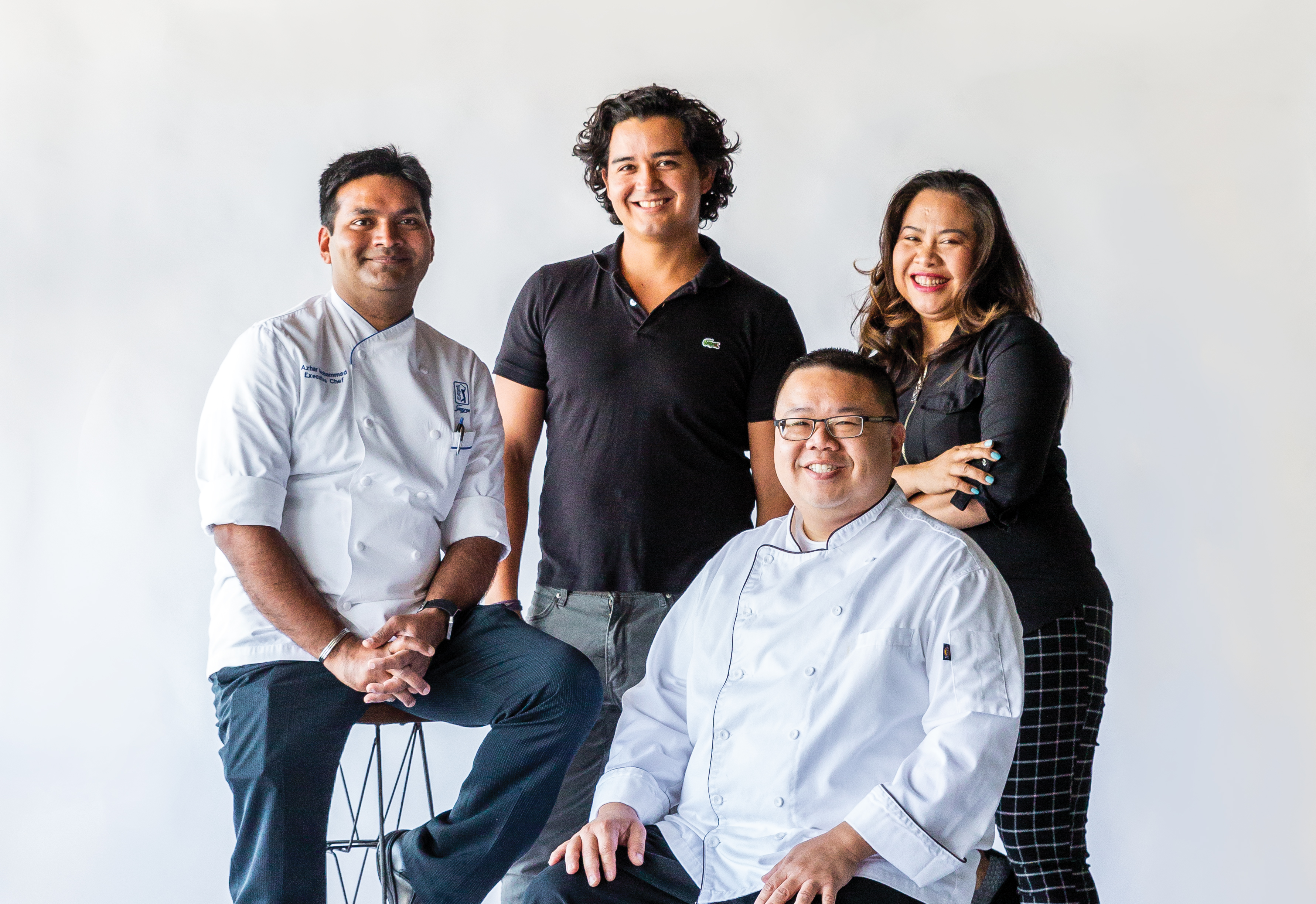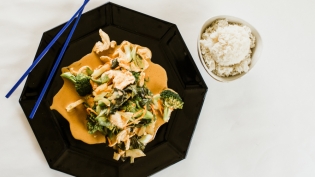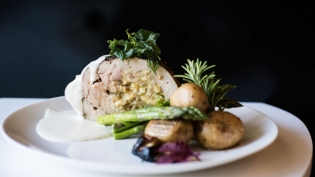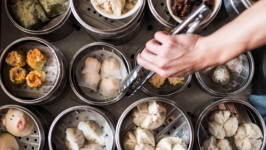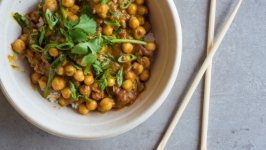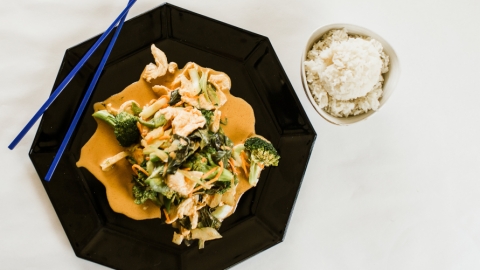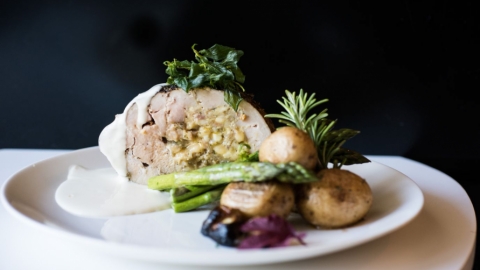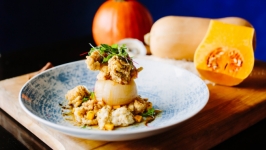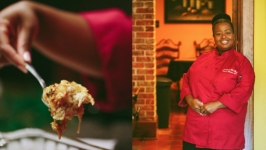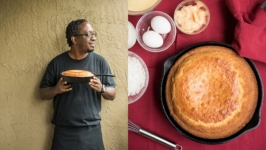Chef's Round Table: Global Flavors
Chef's Round Table is a back-of-the-house conversation series where we sit down with local chefs to get an inside look at the questions and conversations taking place in kitchens throughout Northeast Florida. Chefs change with each new round table, as do topics discussed. For the Explore Issue, we caught up with the following chefs:
Azhar Mohammad, TPC Sawgrass
Marcel Vizcarra, Llama Restaurant
Nancy Straw, Simply Tasty Thai
Dennis Chan, Blue Bamboo Restaurant
EDITOR’S NOTE:
Chefs for this issue were invited to participate based on the following criteria: participants are chefs at local restaurants where dishes are representative of cuisines from other countries and they are actively involved in menu development and sourcing for their restaurants. Criteria will change with each issue and chefs invited to participate will vary. Want to be included in the next discussion or have a chef you'd love to see featured? Drop us a line at editor@edibleneflorida.com.
***********
When it comes to menu planning and creating specials, where do you get your culinary inspirations?
MARCEL: One source comes from my country. Peru is many countries in one, a multicultural melting pot: the Incas, the Spanish, slaves from Africa, Italians, Japanese, Chinese–they all brought their cuisines so it has become a culinary fusion. I have learned a lot from that. The other part is from my mom. She was born with a super developed palate; she can remember something she tried 20 years ago and replicate it. Her dad was French from Lyon and her family has a strong cooking tradition. I started cooking with her when I was 8 years old. She has been very supportive, but also very demanding. I would spend hours cooking something and she would taste it and not like it. So I would always try my hardest to please her. When my mom came and tried the restaurant, she loved it. Finally! I knew I made it. Now she calls me for advice on how to cook some dishes. I also travel as much as I can. When I go back home, it is like a playground, going from market to 5-star restaurant to street food. I think Peru is an important place to go to as a chef because of the diverse experience. You can see how all the different cultures melted together.
AZHAR: My culinary inspirations come from the traveling I have done and seeing how the same ingredient can be used in different ways in all the different cuisines. Take chickpeas, for instance. Dishes using that ingredient are so different in the Middle East than they are in India or here. And seeing the different applications, I think about how I can play around with the food. I’m originally from India, but I have worked around the world. I’ve spent time in the Cayman Islands, Dubai, New Orleans, St. Louis, Puerto Rico, Asheville and Austin. When I became an executive chef, and I had a chance to create my own menu, I started implementing everything I learned from all those chefs to create a kind of fusion cuisine. I landed at TPC Sawgrass in early 2018 and when I designed the menu, I took what was good from all those regions. Feedback from customers gives me the courage to play with flavors more.
NANCY: I have a bit of a different background. I am a Navy wife and when I moved to town over ten years ago, I was homesick. I missed my food very much. I went to every Thai restaurant in Jacksonville, looking for my kind of food. None of them hit my expectations, so I started to cook my own cuisine. Still it seemed like the flavor was missing something. I called my mother and asked her what was supposed to go in this or that dish to make it more authentic. She told me the recipes. When I started Simply Tasty Thai, I asked her to come here and help me. We have the same philosophy–we don’t want to use something that is not Thai. I go back to Thailand at least twice a year, and attend a class or two. I have to learn something new there. My inspiration also comes from cooking shows.
DENNIS: I’m the local boy in this group, born and raised in Jacksonville. My family is Chinese, my grandfather immigrated from Canton, China for the climate here. I went to the Culinary Institute of America, then worked for Ming Tsai up north, big restaurants and chains. That all inspired me when I decided to continue my family legacy in my home town. My family has had 12 restaurants in Jacksonville; my grandfather had one of the first Chinese restaurants. When I opened Blue Bamboo, I meant to have more world influences, with some Southern, but the menu has evolved over the years. I’m also inspired by travel. I take a big trip every year. Last year I went to China, and something kept drawing me to the street markets. I found scorpions, donkey burgers, things that people here won’t eat. Nor could I source here. But I also found things that I could translate into ingredients here. The bigger inspiration has been from cookbooks. I’m such a nerd when it comes to cookbooks. It started when I went to culinary school; when I had free time, instead of partying, I always went to the library because there was such a huge selection. That’s a virtual traveling opportunity. When you read a cookbook, you learn how the author feels about food, and that has helped shape my own views.
MARCEL: I started reading a cookbook called Peru by Gaston Acurio recently, and the writing is like poetry. He talks about letting the garlic and onions slowly cook together until they can understand each other, or when you use fish heads to make a stock, boil them long enough to steal their intelligence.
Tell us about sourcing ingredients needed to make your dishes taste as authentic as possible and whether you have to substitute when you can’t find a particular food.
MARCEL: Sourcing locally is not always realistic at my restaurant. It’s pretty much impossible to find all the ingredients in St. Augustine that I want to use. Peru has a rich soil, so when I tried to grow giant purple corn like back home, it was slightly pink. It doesn’t grow the same. I import a lot of the ingredients. The challenge is finding a good vendor. Most of the time what I do is find a cheap one-way flight from Jacksonville to Miami, pick up a bunch of products and rent a car to drive it all back. When I started to cook, I took traditional Peruvian food and flavors and used French training and techniques to get the best from Peruvian flavors. Sometimes I have some Peruvian customers ask me why I use hangar steak when I make a traditional dish called Lomo Saltado. They complain that it’s not the usual cut of meat, but I want to get the best flavor and I love the flavor of hangar steak – I think it is the most tasty cut.
NANCY: Most of the Thai restaurants here were using only one kind of basil, from the store, and it didn’t have the smell that I wanted to have. So I started growing a lot of herbs like Thai chili, basil, Tulsi (holy basil), galangal, kaffir lime. One or two leaves make a difference in my cooking; when you pick it in the morning, it still has the smell. I also get ingredients from La Salsa, the Asian market on Beach Boulevard.
AZHAR: Our menu is not just one cuisine, so the majority of the ingredients we can get locally. We look for suppliers that have the best products, and if none of them work we will make our own. For example for the Indian Butter Chicken dish, we make our own garam masala because that is the most important ingredient. I’ll get the whole spices and I’ll make my own. Same with the Ras al Hanout. It’s almost 90 spices but it’s worth it. Sometimes we work with the local Asian or Indian stores and have them special order ingredients. We went to several stores to find the right empanada dough, and we couldn’t find it. We ended up learning about a local restaurant where the cook was making the kind of dough we wanted and she made 500 shells for us. We try not to substitute. There are local sources, sometimes it’s a matter of asking the right person.
DENNIS: We can usually source from local markets, like Jax Oriental Market – they have their own farm in Switzerland (Florida), and they grow beautiful Napa cabbage and other Asian ingredients. The owners of the market have a trucking company that goes to Atlanta and Miami to bring back ingredients. The availability of authentic ingredients has definitely increased since Blue Bamboo opened. Take for instance persimmons – that’s something my family has always grown, we’ve always had at least 3 different varieties. Now there’s a Filipino doctor who planted a grove several years ago. He had such an abundant supply last year that the grove was opened to the public. I thought that would be fun, and before you knew it they were all picked. La Salsa is one of my favorite markets. The owner started as a vendor at the Beach Boulevard Flea Market and now has a storefront. I find things there that I don’t find anywhere else in Jax.
How do you as chefs help educate your guests on what they are eating and encourage them to try things that are not familiar to them?
NANCY: People may be familiar with Thai food, but because the way I cook dishes may not be exactly as they have eaten it somewhere else, they ask me why it looks like it does, or tastes different than the way they have had it somewhere else. I say forget about what you have eaten before, this is my cooking. I like to describe Thai cuisine has Indian and Chinese food coming together. The curry may originally have an Indian background, but they use spices to make curry paste and in Thailand we use fresh herbs. Stir fry comes from China in the north, but the Thai version may have a stronger flavor.
MARCEL: When I arrived in St. Augustine, it looked like everyone here had the same menu. I wanted to try something exotic, but I couldn’t find it. When I talked about opening a Peruvian restaurant, everyone said nobody’s going to eat Peruvian food. Two years later, I guess there is an interest in the food! My guests are usually looking for something different so I want to provide an experience, a chance for them to develop their palate. We are constantly working on educating our customers. My menu is small and it showcases the different cultures, climates and geography of my country. The tasting menus are like a little trip to Peru’s main regions, with ceviche from the coast to guinea pig or beef hearts from the mountains, then to the jungle with Amazonian Pacu fish. It’s the responsibility of the servers to translate what we do in the kitchen, because every dish has a story behind it. Often I come out of the kitchen and give some of the history and culture of the food, all the different influences that became a fusion in Peru.
DENNIS: At Blue Bamboo we have cooking classes and market tours. We shop, come back to the restaurant and cook what we bought. With our cooking classes and tasting dinners, we are constantly educating our guests. A lot of times the dishes on the tasting dinners become specials or we add them to the menu. Many times we have served dishes that I thought would be a winner, and they ended up being a flop. Sometimes it is a texture thing, and sometimes the flavors are just too authentic.
NANCY: I tell my guests that if they want an authentic Thai dish, they should try Tiger Cry. It’s called that because it is so spicy, it makes a tiger cry. If a guest wants this dish served mild, I tell them, sorry it is not called Tiger Laughing, it is Tiger Cry. You have to make it hot.
AZHAR: The menu at TPC has some things that are familiar crowd-pleasers, but there are also some things we experiment with. I tried falafel in Dubai and it was unlike any that I had tasted before. I adapted that and now we have a falafel “Mignon” on the menu. We had a mixed reaction when I arrived at TPC Sawgrass and changed the menu. About 80% of our guests are regulars. They had a relationship with the employees, with the menu itself. When I came onboard, the expectation was that I would slowly implement changes. But after two weeks I realized I didn’t relate to the menu and I said I wanted to change the whole thing. There was a big hue and cry, people were saying you can’t do that, the members won’t like it. But the menu wasn’t a reflection of me and what I wanted to serve. So we changed most of the menu. I made sure I was in the dining room, walking the tables, talking to the guests. Now, the new dishes have a following and people don’t want things removed. We added chicken tinga nachos and at first people asked why we took the old nachos off the menu. They were just tri-colored nachos with cheese, what was so special about them? Now guests say the new achos are the best they ever had. Overall I believe that people want to try something authentic. If it has a good flavor they’re open to it.
DENNIS: We are very lucky that we have such adventurous diners in the area who want to try global flavors. And we’re also lucky to have the availability of so many places. There are so many restaurants here that do a really great job of serving food from around the world.


